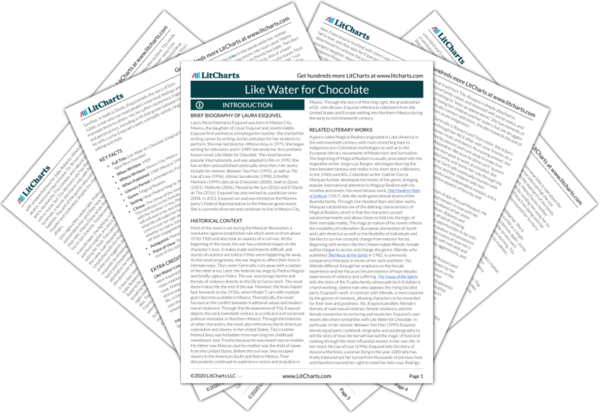Tradition vs. Revolution
Like Water for Chocolate takes place during the Mexican Revolution, which challenged social and political systems and provided a context for individuals to question existing values and structures. It is against this national scene that the protagonist, Tita, and her sisters face their mother’s authority and their society’s expectations of women. The individual struggle to rebel, like the national struggle for liberation from the oligarchy (a government run by a few powerful people only)…
read analysis of Tradition vs. RevolutionFemininity and Women’s Roles
Within the historical context of greater social change, the novel allows femininity to be defined differently between characters and within each character’s development. Challenging the classic dichotomy between the “virgin/mother” and the “whore” (traditional stereotypes of femininity), the novel allows each female character to struggle with her needs for belonging and security, as well as her desires for adventure, sex, and liberation.
On the surface, Tita fulfills many characteristics of the pure virginal archetype, such…
read analysis of Femininity and Women’s RolesLove
The novel portrays love as a magical force capable of defying reality. It is genuine love, not social or biological structures, that creates familial and romantic bonds. True love is a unique event, capable of incredible resilience. Furthermore, true love doesn’t always answer to social codes of morality.
In the novel romantic love forms a spiritual bond that matters more than the formal structure of marriage. Central to the book is the notion that Pedro…
read analysis of Love
Emotion and Repression
Within the novel, characters with intense emotions are portrayed as more fully alive. The possession of a wide range of emotions represents a healthy, liberated spirit—but social norms and family dynamics, if left unbalanced by values of individual freedom, can lead to repression of normal emotions. Abusive relationships, in particular, punish normal experiences of emotion and can lead to physical and emotional sickness. Repression is linked to self-sacrifice and duty, while emotion is linked to…
read analysis of Emotion and RepressionFood and Cooking
The theme of food is central to the novel’s structure and meaning. Each chapter begins with a recipe for a dish that Tita cooks during that chapter. Often interspersing her narration with detailed cooking instructions, Esquivel uses food as a constant in the changing lives of her characters and as a medium to express many different truths.
Within the confines of her abusive relationship with her mother and within traditional female domestic roles, Tita finds…
read analysis of Food and CookingViolence and Abuse
As the novel is set during the Mexican Revolution, violence is inextricably linked to the time period and to the theme of liberation. In order to liberate themselves of the violent rule of the oligarchy, the rebels respond with organized political violence. Both the old oligarchy and the leaders of the rebellion are predominantly men, creating a sense that violence is a necessary part of maleness and male-dominated culture (or machismo). The novel, however…
read analysis of Violence and Abuse











